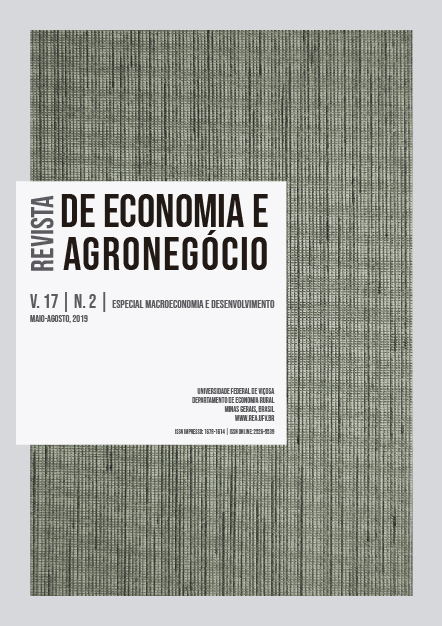PRODUTIVIDADE AGREGADA E HETEROGENEIDADE DO CAPITAL: UMA ANÁLISE QUANTITATIVA
DOI:
https://doi.org/10.25070/rea.v17i2.7935Resumo
Este artigo analisa quantitativamente a importância relativa dos fatores que determinam o desempenho econômico dos países. Em especial, é incorporada à análise a possibilidade do capital ser heterogêneo. Estimativas da qualidade do capital são feitas para cada país, resultantes de um modelo teórico, e a importância de cada um dos componentes é analisada. Mesmo depois do ajuste, a qualidade do capital físico não explica grande parte da experiência de crescimento dos países. Além disso, é feita uma análise para o caso brasileiro com o arcabouço desenvolvido durante o período que vai de 1970 até 2003. Conclui-se nesta análise que a heterogeneidade do capital não explica grande parte da experiência de crescimento do Brasil.
Downloads
Referências
BARRO, R. J.; LEE, J.-W. International data on educational attainment: updates and implications. Oxford Economic Papers, Oxford Univ Press, v. 53, n. 3, p. 541-563, 2001.
EROSA, A.; KORESHKOVA, T. A.; RESTUCCIA, D. How important is human capital? a quantitative theory assessment of world income inequality. The Review of Economic Studies, v. 77, n. 4, p. 1421-1449, 2010.
GOLLIN, D. Getting income shares right. Journal of political Economy, JSTOR, v. 110, n. 2, p. 458-474, 2002.
HALL, R. E.; JONES, C. I. Why do some countries produce so much more output per worker than others? The quarterly journal of economics, Oxford University Press, v. 114, n. 1, p. 83-116, 1999.
HANUSHEK, E. A.; KIMKO, D. D. Schooling, labor-force quality, and the growth of nations. The American Economic Review, v. 90, n. 5, p. 1184-1208, 2000.
HESTON, A.; SUMMERS, R.; ATEN, B. Penn world table version 6.2. university of pennsylvania. Center for International Comparisons of Production, Income, and Prices, Philadelphia, Pa. Available at http://pwt. econ. upenn. edu, p. 22, 2006.
JORGENSEN, D. W. Information technology and the u.s. economy. The American Economic Review, v. 91, n. 1, p. 1-32, 2001.
JOVANOVIC, B.; ROB, R. Solow vs. solow: Machine prices and development. NBER Working Paper, n. w5871, 1997.
KLENOW, P. J.; RODRIGUEZ-CLARE, A. The neoclassical revival in growth economics: Has it gone too far? NBER Macroeconomics Annual, JSTOR, p. 73-103, 1997.
LANGONI, C. G. Distribuição da renda e desenvolvimento econômico do brasil. Fundação Getúlio Vargas, 1973.
MANKIW, N. G.; ROMER, D.; WEIL, D. N. A contribution to the empirics of economic growth. The quarterly journal of economics, Oxford University Press, v. 107, n. 2, p. 407-437, 1992.
MANUELLI, R. E.; SESHADRI, A. Human capital and the wealth of nations. 2005.
MINCER, J. Schooling, experience, and earnings. human behavior & social institutions no. 2. ERIC, 1974.
PARENTE, S. L.; PRESCOTT, E. C. Barriers to riches. MIT Press Books, The MIT Press, v. 1, 2002.
PSACHAROPOULOS, G. Returns to investment in education: A global update. World development, Elsevier, v. 22, n. 9, p. 1325-1343, 1994.
SCHOELLMAN, T. Education quality and development accounting. The Review of Economic Studies, v. 79, n. 1, p. 388{417, 2012.
SOLOW, R. M. A contribution to the theory of economic growth. The quarterly journal of economics, Oxford University Press, v. 70, n. 1, p. 65-94, 1956.
SOLOW, R. M. Technical change and the aggregate production function. The review of Economics and Statistics, JSTOR, v. 39, n. 3, p. 312-320, 1957.
SOLOW, R. M. Investment and technical progress. In: ARROW, K. J.; KARLIN, S.; SUPPES, P. (Ed.). Mathematical methods in the social sciences. Stanford: Stanford University Press, 1960.
YOUNG, A. The tyranny of numbers: confronting the statistical realities of the east asian growth experience. The Quarterly Journal of Economics, Oxford University Press, v. 110, n. 3, p. 641-680, 1995.
Downloads
Publicado
Como Citar
Edição
Seção
Licença
Autores que publicam nesta revista concordam com os seguintes termos:
O artigo não infringe direitos autorais e estes direitos, no caso de o artigo ser aceito para publicação, serão cedidos, de forma exclusiva, à Universidade Federal de Viçosa.




